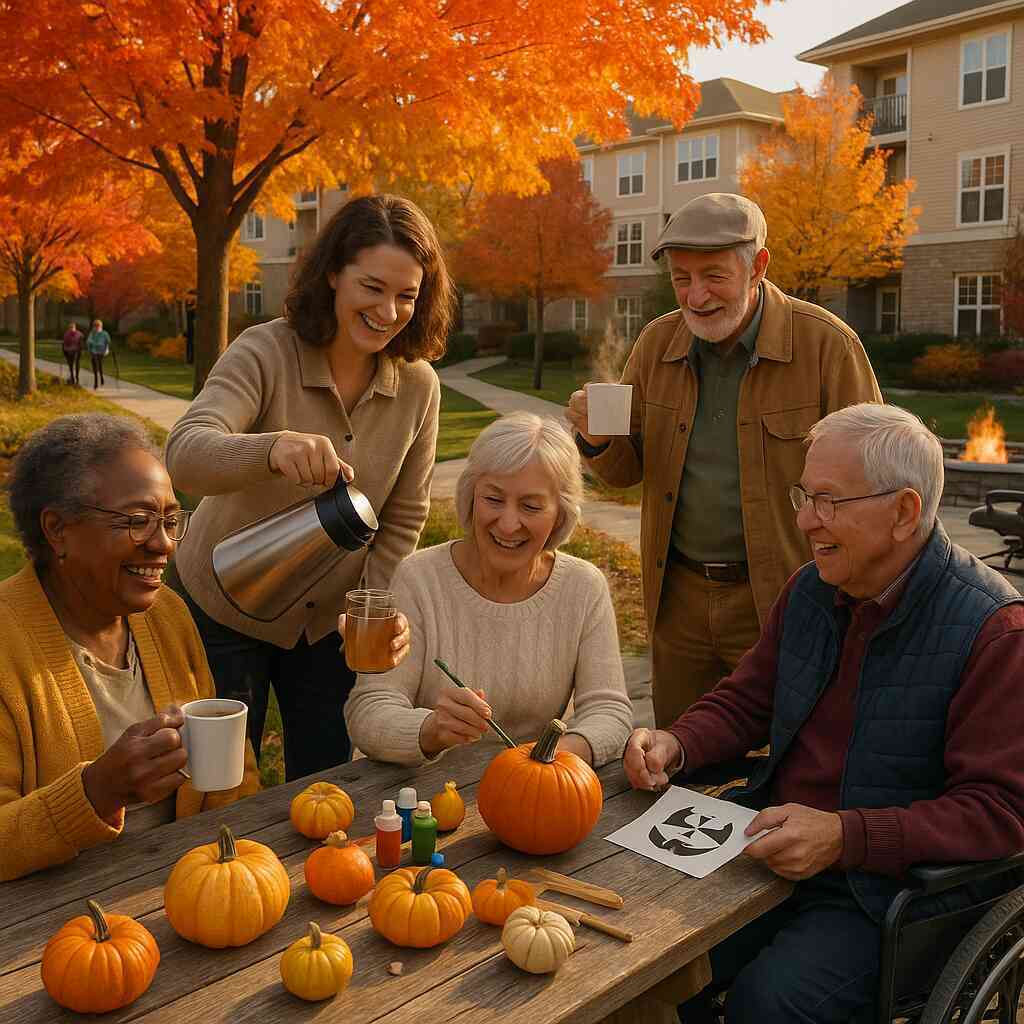
Exploring Long-Term Care Facilities: What to Expect
June 7, 2025
The Path to Long-Term Care: Understanding Your Options
Navigating the Maze of Senior Living Facilities
Embarking on the journey to find the right senior living facility can feel overwhelming at first. With a myriad of options in all 50 U.S. states, understanding your priorities is crucial. Whether seeking independent living or comprehensive geriatric care services, it’s essential to identify what aligns with your senior’s lifestyle preferences. Start by exploring nearby communities and utilizing online resources to see what’s available. Even if the terminology seems complex, focusing on what suits your family will ease the process. Furthermore, leveraging tools like SeniorLivingFacilities.com helps in connecting directly with communities that pique your interest.
Key Considerations in Senior Care Planning
When planning for senior care, a thoughtful approach ensures meeting both current and future needs. Recognize the importance of location, available healthcare, and community engagement programs. Investigating the available support services aids in comprehensive senior care. Financial planning is another pivotal element and should address potential long-term costs. Additionally, understanding senior care planning resources available in your state helps guide informed decisions. Embracing a proactive plan offers peace of mind to both seniors and their families.
Decoding Long-Term Care Options
Understanding the spectrum of long-term care options available clarifies the decision-making process. From assisted living facilities to specialized nursing home care, each option provides varying levels of support and independence. Evaluate the long-term care facilities near me to assess their suitability for your needs. Consider factors such as medical support, social activities, and accommodation type. Tailoring choices to a senior’s health and personal preferences ensures a seamless transition. Moreover, reviewing multiple facilities provides a comprehensive view, matching the specific nuances of senior living requirements with appropriate solutions.
The Intricacies of Choosing the Right Facility
Evaluating Geriatric Care Facilities and Their Services
Choosing the right geriatric care facility involves a thorough evaluation to meet the unique needs of a senior. It’s critical to conduct a comparison of geriatric care facilities to understand the spectrum of services offered. These range from medical assistance to recreational activities designed to enhance the quality of life. Facilities must also cater to varying health conditions and accessibility needs. Performing site visits and speaking with staff can provide insight into the community’s ethos. Additionally, assessing the cost in relation to the services rendered is crucial, ensuring an optimal balance between affordability and quality care.
Understanding Assisted vs. Independent Living
Deciding between assisted and independent living requires weighing multiple factors that define each option. Understanding the fundamental differences, such as the level of care and independence offered, is vital. Assisted living encompasses daily aid, while independent living fosters autonomy among its residents. Utilizing resources like understanding assisted and independent living offers comprehensive insights into making informed decisions. Family involvement in this phase is paramount, ensuring that the choice aligns with both the senior’s health needs and lifestyle goals. Furthermore, exploring various communities can reveal diverse offerings that cater to personalized preferences and future requirements.
Factors Influencing Senior Housing Choices
Several factors influence the decision-making process when selecting senior housing. Geographical location often tops the list, as convenience and proximity to family play significant roles. Financial considerations, including budgeting for long-term costs, are equally critical. Understanding the range of activities of daily living for seniors provided by prospective communities can influence preference. Moreover, medical support and the availability of specialized services for conditions such as dementia or mobility issues must be taken into account. Social and recreational opportunities should also align with a senior’s interests to enhance community integration and fulfillment. Making an informed decision involves balancing these diverse factors, with the overarching goal of ensuring a comfortable and fulfilling eldercare experience.

Life Within: What to Expect in Senior Communities
Unpacking Daily Life and Community Engagement for Seniors
Daily life in senior communities is thoughtfully structured to foster engagement and fulfillment among residents. These communities offer an array of activities tailored to accommodate the varied interests and abilities of seniors. From group outings and artistic endeavors to educational lectures, there’s a wide selection designed to encourage participation and social interaction. This environment not only enhances daily living but also helps seniors build a meaningful sense of belonging. Additionally, senior communities often provide access to amenity-rich common areas where residents can relax and socialize with ease.
The community aspect plays a pivotal role, forging connections among residents through organized events and informal gatherings. For seniors choosing an independent senior living concept, the proximity to peers fosters a vibrant social life, contributing to overall well-being. Robust activity schedules and volunteer opportunities also empower seniors to remain active contributors to their community. Programs emphasizing lifelong learning and hobbies aim to enrich the living experience, making them an integral part of daily life in senior communities.
Exploring Social Activities and Senior Wellness Programs
Social activities within senior living facilities are not mere add-ons but core elements of their offerings. These activities range from fitness classes and sports competitions to dance sessions and themed parties, effectively catering to diverse interests. Wellness programs often include personalized fitness plans and recreational therapies tailored to individual capabilities. Communities emphasize holistic health, incorporating activities that nurture physical, mental, and emotional well-being.
Furthermore, senior wellness programs are backed by professional staff trained in geriatric care, ensuring that activities are both enjoyable and safe. The goal is to provide a balanced schedule that promotes physical activity, social engagement, and cognitive stimulation. These activities spark joy, foster friendships, and enable seniors to explore new interests, ensuring an enriched quality of life.
Beyond structured activities, informal social interactions are encouraged throughout the day. Community spaces are designed to invite conversation and camaraderie, facilitating connections among residents. This social network is crucial in maintaining a vibrant atmosphere where seniors feel valued and cherished.
Health and Wellness: Comprehensive Elder Care Support
Health and wellness form the cornerstone of senior communities, with comprehensive support systems designed to cater to wide-ranging needs. Access to nursing care, routine health assessments, and medical assistance are standard components of these facilities. Programs emphasize preventative care and proactive management of chronic conditions, ensuring that seniors receive appropriate attention and intervention.
Skilled nursing services offer tailored support for residents requiring higher levels of care, such as those in need of rehabilitation or complex medical management. State-of-the-art healthcare facilities on-site assure families of their loved ones’ well-being, providing peace of mind. Moreover, initiatives that focus on mental health and emotional support are integral, recognizing the importance of a holistic approach.
Integrated elder care advice is available to guide residents and families through healthcare decisions, aligning with personalized care plans. This thorough approach to healthcare assistance in senior living ensures residents maintain optimal health in a supportive environment. The intricate balance of care and wellness in these communities manifests in the enhanced quality of life enjoyed by residents.
Practical Insights: The Transitioning Process
Personalized Elder Services: Crafting a Transition Plan
Creating a personalized transition plan is essential when moving to a senior living community. This plan should be comprehensive and address the specific needs and preferences of the senior involved. Begin by considering the immediate and future requirements in terms of healthcare, social activities, and personal care. Working closely with the intended facility can ensure that elder services are tailored effectively. Consulting with professionals who offer transitioning to senior care guidance can provide valuable insights and help ease the transition.
Involvement of all family members in the transition planning process ensures that the decision is well-informed and agreeable to everyone involved. Understanding past routines and preferences allows for better integration into the new environment. Engaging in open discussions about expectations and potential challenges can minimize stress and create a smoother adjustment. It’s essential to maintain an open line of communication with the facility staff, fostering a collaborative approach to crafting a seamless transition.
Financial Aspects of Eldercare and Housing Options
Understanding the financial aspects of eldercare is critical when considering long-term care facilities. Costs can vary significantly depending on the level of care required, from basic housing to comprehensive geriatric care services. Exploring different housing options helps determine the most suitable financial path. Make sure to prioritize elderly care financial planning as part of your strategy.
Budgeting for both current and potential future needs is crucial. Consider ongoing costs such as daily care, medical expenses, and additional services that may arise as health needs change. Investigating various payment options, including insurance and government programs, can provide a clearer financial picture. Staying informed about possible financial assistance programs enables families to plan for sustainable eldercare solutions.
How to Leverage Family Caregiver Guidance
Family caregiver guidance is a valuable resource in the transition to senior care. These individuals often provide emotional support, firsthand knowledge of the senior’s preferences, and practical assistance. Leveraging their insights can significantly enhance the transition process. Ensuring that caregivers are actively involved and informed aids in addressing concerns and adapting to the senior’s specific needs.
Family caregivers play a crucial role in maintaining continuity of care and personal connection. Establishing a partnership between caregivers and facility staff facilitates better information sharing and enables a more personalized care approach. Empowering caregivers through access to relevant resources and support systems enhances their ability to contribute positively. Remaining adaptable and receptive to feedback ensures that the transition remains focused on improving the senior’s quality of life in elder communities, fostering a nurturing environment that prioritizes well-being.

Looking Ahead: Elevating Quality of Life in Eldercare
Age-in-Place Strategies for Post-Retirement Living
As seniors look to their futures, age-in-place strategies become pivotal in ensuring a comfortable and fulfilling post-retirement life. These strategies focus on allowing seniors to remain in their homes or communities while receiving the necessary levels of care. A crucial aspect of this involves adapting homes to meet changing health and mobility needs. Simple modifications such as installing grab bars or creating wheelchair-accessible spaces can make a significant difference. Additionally, technological advancements allow for remote monitoring and telehealth visits, keeping healthcare accessible even at home. Implementing age-in-place retirement strategies also empowers seniors to maintain autonomy, reducing stress associated with moving to a new environment.
Proactively planning these strategies ensures that seniors can stay connected with their communities and families, maintaining social ties that are vital for emotional and mental well-being. These plans provide a framework for financial security, as they often involve budgeting for healthcare and potential home modifications. Moreover, age-in-place approaches can be integrated with local elder care services, offering personalized support while enabling independence. This holistic and forward-thinking planning enhances the quality of life for seniors, supporting them through their golden years with dignity and comfort.
Ensuring Senior Lifestyle Enhancement
Enhancing the lifestyle of seniors within eldercare communities is essential for nurturing their overall well-being. This involves a multifaceted approach that addresses physical, emotional, and cognitive needs. Senior living facilities prioritize creating environments rich with opportunities for personal growth and fulfillment. They provide curated wellness programs that are tailored to individual preferences and needs, ensuring seniors have access to activities that resonate with them. Engaging in arts, culture, and social events not only entertains but also fosters mental agility and social interaction.
Communities are increasingly focusing on providing comprehensive elder services solutions that address all aspects of senior care. These solutions encompass nutrition plans, fitness routines, and accessible healthcare services, collaboratively enhancing life quality. The inclusion of learning opportunities, such as workshops and lectures, keeps seniors intellectually stimulated and curious. Additionally, fostering environments where seniors can contribute positively through volunteering or mentorship roles gives them a sense of purpose and validation, reinforcing their self-esteem and social value.
Fostering Community Engagement and Support Networks
Building strong support networks within senior communities fosters a sense of belonging and security among residents. Establishing vibrant networks involves creating spaces that encourage interaction and connection, both formal and informal. Senior living communities often organize group events, volunteer initiatives, and peer-led clubs to motivate social engagement. This structured social environment helps prevent isolation, a common issue among the aging population, and promotes mental health resilience.
Encouraging participation in community activities nurtures friendships and mutual support among seniors. Support networks extend beyond social aspects to include healthcare collaborations, where professionals and residents work together to manage individual health plans. Such integrated approaches influence the community’s stability, assuring seniors and their families of available comprehensive support.
Families can play a critical role in this network, participating in community events and maintaining open communication with staff, ensuring continuity of care, and fostering trust. For those considering transitioning into senior care, understanding these dynamics can ease adjustments, making the process smoother and more reassuring. By prioritizing community engagement, eldercare environments become supportive havens where seniors thrive, ensuring that the later chapters of life are filled with meaning and interaction.
Frequently Asked Questions
Question: What long-term care options are available through Senior Living Facilities?
Answer: At Senior Living Facilities, we offer a wide range of long-term care options to suit the varied needs of seniors. Check out The Ultimate Guide to Senior Living Facilities Near Me. Our comprehensive database includes senior communities across all 50 US states, featuring independent living, assisted living, and nursing homes for the elderly. Each of these facilities provides a unique mix of medical care, social activities, and support services tailored to the residents’ needs. Our platform allows you to assess and compare different communities, ensuring you find the perfect match that aligns with your priorities and the eldercare advice you require.
Question: How can Senior Living Facilities assist in senior care planning for transitioning to senior care?
Answer: Senior Living Facilities is committed to making the transition to senior care as smooth as possible. We provide personalized guidance on understanding eldercare financial planning and can help craft transition plans, ensuring all aspects of care are covered. Our team offers insights into the nuances of senior care planning, including evaluating geriatric care facilities, understanding healthcare needs, and comparing assisted and independent living options. We place a strong emphasis on family involvement, ensuring that all decisions are well-informed and geared toward enhancing the quality of life in eldercare facilities.
Question: What should families expect when choosing a senior living facility for long-term care?
Answer: Families should expect a multidimensional approach when selecting a senior living facility. Our extensive resources help families understand various factors influencing senior housing decisions, such as geographical location, healthcare access, and community engagement opportunities. Dive into What Makes Senior Living Facilities Stand Out Now? At Senior Living Facilities, you can explore different senior housing solutions, create personalized elder services plans, and compare healthcare assistance available at each facility. These steps are crucial to ensuring your loved one enjoys quality of life and full integration into their new community.
Question: How do Senior Living Facilities ensure the enhancement of social activities for seniors within communities?
Answer: Our platform highlights senior communities that prioritize vibrant social activity schedules and wellness programs. These offerings include fitness classes, art and educational workshops, and other recreational activities designed to cater to varied interests. Such programs are integral to maintaining physical and mental health, fostering social bonds, and ensuring ongoing engagement within the community. By showcasing facilities with robust senior lifestyle enhancement programs, we help families select environments that will offer their loved ones a fulfilling and enriching experience during their post-retirement years. Refer to How Senior Living Facilities Enhance Social Connection.
Question: What should I focus on when exploring long-term care facilities: what to expect through Senior Living Facilities?
Answer: When exploring long-term care facilities with us, focus on identifying facilities that align with your current and future needs. Evaluate factors such as the levels of independence offered, the scope of healthcare assistance, and community support networks available. Our platform allows you to search for facilities based on location and compare various senior living options near you to find the best match. This ensures that you select a facility that supports comprehensive senior care, helping ease the transition and maintaining a high quality of life for your loved one.


